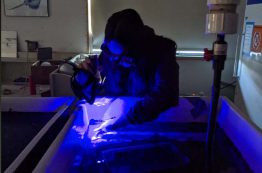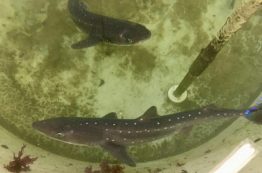Emily Carrington, resident scientist at the UW’s Friday Harbor Laboratories, was named a AAAS Fellow, according to a Jan. 26 announcement by the American Association for the Advancement of Science. She is among 564 new fellows from around the world elected in 2021, who are recognized for “their scientifically and socially distinguished achievements” in science and engineering. Carrington is honored for her research contributions in biomechanics and ecophysiology, as well as efforts to promote diversity and inclusion in science.
Read more at UW News »Glowing fish teeth answer questions about tooth replacement rates
One of the facts of life for humans is the replacement of baby teeth with permanent adult teeth. Whether pulled out prematurely, wiggled loose by eager hands or naturally falling out unexpectedly, this occasion marks an important milestone in the maturation process that is shared amongst all vertebrates in some form. Imagine, though, losing and replacing a tooth every single day.
Read more »Friday Harbor Laboratories' observation system collects and shares real-time data about Salish Sea
Friday Harbor Laboratories (FHL) recently established the Friday Harbor Laboratories Ocean Observatory (FHLOO), vastly expanding their capabilities to collect and share real-time data about the surrounding marine environment. Connected to the larger Northwest Association of Networked Ocean Observing Systems (NANOOS), FHLOO takes continuous seawater measurements such as salinity, temperature, CO2, oxygen and chlorophyll, in addition to monitoring microplankton. While the system has been taking measurements since the summer of 2020, the ability to live-stream its data is new, providing a window into the Salish Sea accessible to researchers, students and the public.
Read more »New 3D images of shark intestines show they function like Nikola Tesla’s valve
Contrary to what popular media portrays, we actually don’t know much about what sharks eat. Even less is known about how they digest their food, and the role they play in the larger ocean ecosystem. For more than a century, researchers have relied on flat sketches of sharks’ digestive systems to discern how they function — and how what they eat and excrete impacts other species in the ocean.
Read more at UW News »Thousands of baby sea stars born at UW lab are sign of hope for endangered species
Just a few days shy of the first day of spring, scientists at Friday Harbor Laboratories on San Juan Island had reason to celebrate. Dozens of juvenile sea stars, no bigger than a poppy seed, had successfully metamorphosed from floating larvae to mini star — the important first step toward becoming an adult. Between now and then, these sunflower sea stars, the largest sea star species in the world, will grow up to 24 arms and a colorful body the size of a serving platter.
Read more at UW News »





